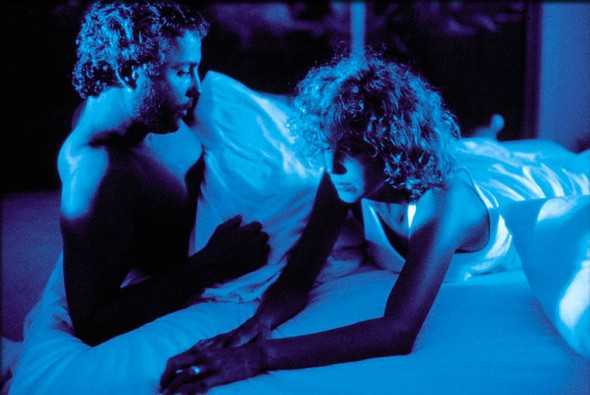
Manhunter

MANHUNTER (MOVIE)
De Laurentiis Entertainment Group
Original release: August 15th, 1986
Running time: 115 minutes
Director: Michael Mann
Writers: Michael Mann, Thomas Harris (novel)
Music: Michel Rubini, The Reds
Cast: William L. Petersen, Kim Greist, Joan Allen, Brian Cox, Stephen Lang, Tom Noonan

To catch a killer, sometimes you have to think like a killer and be willing to see the world they way he sees it. Looking so deeply into the abyss, it might become impossible to step back and remember what it’s like to see things through your own eyes again.
In Michael Mann’s 1986 adaptation of Red Dragon by Thomas Harris, he offers us an effective, atmospheric, and at times disturbing neo-film noir where FBI profiler Will Graham (William Petersen) has no other choice to but to do just that in order to catch a killer.
As a profiler, Graham is able to step out of himself and into the minds of the killers he’s tracking. It’s an ability that frightens him, and he wonders if there’ll come time when he’ll no longer be able to separate the killer from the profiler. His job has already resulted in one nervous breakdown, despite helping to put away Hannibal Lecter (Brian Cox).
He now lives a comfortable seaside life with his wife and young son, but with a new serial killer on the loose, his former boss Jack Crawford (Dennis Farina) pays him a visit to try and draw him out of retirement. The “Tooth Fairy” murders entire families and his M.O. is so bizarre that Graham might be the only hope they have in getting a lead on him.
Graham realises that if he’s to build a profile on the killer and understand his motivations, he needs the help of his old nemesis, Dr. Lecter – a former psychiatrist.

Although he promises his wife he’ll only be looking at evidence, Graham’s pursuit will eventually bring him face to face with the Tooth Fairy, but this is something he already seems to know, whether it be through his profiling or some other kind of intuition.
As Lecter’s first screen outing, oddly enough he is overshadowed by the film’s two main leads played by Petersen and Noonan who are both unforgettable in their roles. Building up to the final showdown between them, cinematographer Dante Spinotti adds to the tense atmosphere with his use of lighting and offtempo/staccato style of filming, achieved by using various cameras shooting at different speeds.
It’s easily one of the best thrillers to come out of the 1980’s and one of the best examples of what a neo-film noir should be. There’s much emphasis on the moral ambiguities of its character and this goes well with the shifting moods of the film.
- Meeha, P (2009) Cinema of the Psychic Realm: A Critical Survey, McFarland & Co Inc ¹
- Conard, T., Porfiri, R. (2007) The Philosophy of Film Noir, The University Press of Kentucky ²
Another aspect of Manhunter that stands out is the music. With its score by Michel Rubini and The Reds, it’s reminiscent of Vangelis and Tangerine Dream yet there’s something edgier to its dreamlike quality and synth-driven soundscapes. It too underscores the suspense and horror of what’s happening but it also makes its quieter moments a serene experience to soak up.
While it might have missed its chance at the box office, it’s gone on to become a cult classic and it’s not hard to see why. It’s a cinematic gem with so many layers that each time you watch it you experience a new one.

Patrick Samuel
The founder of Static Mass Emporium and one of its Editors in Chief is an emerging artist with a philosophy degree, working primarily with pastels and graphite pencils, but he also enjoys experimenting with water colours, acrylics, glass and oil paints.
Being on the autistic spectrum with Asperger’s Syndrome, he is stimulated by bold, contrasting colours, intricate details, multiple textures, and varying shades of light and dark. Patrick's work extends to sound and video, and when not drawing or painting, he can be found working on projects he shares online with his followers.
Patrick returned to drawing and painting after a prolonged break in December 2016 as part of his daily art therapy, and is now making the transition to being a full-time artist. As a spokesperson for autism awareness, he also gives talks and presentations on the benefits of creative therapy.
Static Mass is where he lives his passion for film and writing about it. A fan of film classics, documentaries and science fiction, Patrick prefers films with an impeccable way of storytelling that reflect on the human condition.
© 2022 STATIC MASS EMPORIUM . All Rights Reserved. Powered by METATEMPUS | creative.timeless.personal. | DISCLAIMER, TERMS & CONDITIONS
HOME | ABOUT | CONTACT | TWITTER | GOOGLE+ | FACEBOOK | TUMBLR | YOUTUBE | RSS FEED
CINEMA REVIEWS | BLU-RAY & DVD | THE EMPORIUM | DOCUMENTARIES | WORLD CINEMA | CULT MOVIES | INDIAN CINEMA | EARLY CINEMA
MOVIE CLASSICS | DECONSTRUCTING CINEMA | SOUNDTRACKS | INTERVIEWS | THE DIRECTOR’S CHAIR | JAPANESE CINEMA





